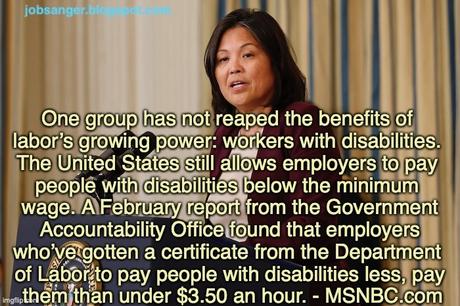
Eric Garcia at MSNBC.com points out that disabled workers are being exploited by being paid less than the minimum wage -- and sadly, it is legal. Here is part of what he writes:
This past year has seen workers in numerous industries strike for better wages. Just last week, SAG-AFTRA, which represents actors, reached an agreement with producers in Hollywood. This came after the Writers Guild of America reached a similar agreement. Similarly, autoworkers made historic gains, thanks in part to the support of President Joe Biden.
But one group has not reaped the benefits of labor’s growing power: workers with disabilities. Despite many strides for people with disabilities, in what is an incredibly degrading relic from the pre-World War II era, the United States still allows employers to pay people with disabilities below the minimum wage. A February report from the Government Accountability Office found that employers who’ve gotten a certificate from the Department of Labor to pay people with disabilities these pittance wages employ about 120,000 such workers. Half earned an absolute pittance, less than $3.50 an hour. Finally, the Department of Labor is taking a step to end the practice.
In September, the department announced that it would hold “stakeholder engagement sessions” to review the program. The first such session was held last month. The last one takes place this week.
In 2020, candidate Joe Biden and all the major Democratic presidential candidates said they’d end subminimum wage labor for people with disabilities. That they all made such a promise showed how much the disability rights movement had pushed the conversation along.
The Biden White House and congressional Democrats wanted an end to subminimum wage labor for disabled people included in the American Rescue Plan. That bill was Biden’s signature Covid-19 relief legislation, and in it, he wanted to raise the minimum wage to $15 for all workers. But when the Senate parliamentarian said raising the minimum wage couldn’t be included in a budget reconciliation bill, efforts to pay disabled people the same as everyone else died on the federal level. . . .
As the shockingly low pay these workers get indicates, the policy practice is exploitative. The February GAO report found that “almost all 14(c) workers had an intellectual or developmental disability, and most were White and of prime working age (25 to 54 years old0.” According to that report, “employers reported few 14(c) workers engaged in competitive employment — which includes earning at least minimum wage in a work setting with individuals without disabilities.”
A 2020 report from the U.S. Commission on Civil Rights found “Persistent failures in regulation and oversight” of employers by the Department of Labor and the Department of Justice. The report says “Section 14(c) may … raise legal issues under Title I of the 1990 Americans with Disabilities Act (ADA), which was intended to ensure wide-reaching and comprehensive civil rights protections for individuals with disabilities. Categorically, under Section 14(c), people with disabilities being paid a subminimum wage are not granted the same protections, nor are they offered the same opportunities that are available to people working at the minimum wage or above.” The report also notes that such workers are not allowed to unionize. . . .
The good news is that this practice has declined. Since 2010, the number of disabled workers in 14(c) facilities has declined from 3,117 to 1,567 in 2019. That number will likely decline as numerous states have ended the practice. And not just blue states: Republican governors, including decidedly MAGA ones like Henry McMaster of South Carolina and Bill Lee of Tennessee, have signed legislation ending the practice. Similarly, Texas Gov. Greg Abbott, who is paralyzed from the waist down and uses a wheelchair, signed legislation banning state contractors from paying people with intellectual and developmental disabilities below the minimum wage.
Even if they bicker with Democrats about the idea of a minimum wage as a whole, it makes sense for conservatives to support ending subminimum wage labor, especially if they believe people should be self-sufficient and, as they say, off the government dole.
But the push to end subminimum wage labor will likely face staunch opposition. The parents of many disabled workers support the places that have hired those workers, such as Goodwill, which has historically used 14(c) certificates and uses the term “special minimum wage” to avoid acknowledging that it pays people below minimum wage. Indeed, one of the dissenting commissioners in the Commission on Civil Rights report argued that getting rid of subminimum wage labor would cause people with disabilities to lose their jobs.
Many of these arguments bear resemblance to the arguments that people have against raising the minimum wage in general. However, Vermont, the first state to get rid of subminimum wage labor, saw 80% of people who were previously paid less enter into competitive integrated employment. The other 20%, according to the National Council on Disability, went into a community support program.
The main argument against subminimum wage labor is that the work that people with disabilities do is no less valuable. Hiring people with disabilities is not an act of charity; it’s not kindness. People who are disabled who work do so for the same reason nondisabled people do: to support themselves and their families. They should be paid the same, too.

